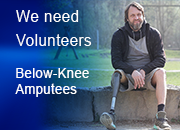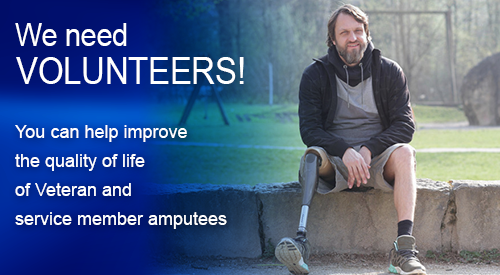The VA Center for Limb Loss and Mobility (CLiMB) is a research group focused on preserving and enhancing mobility in Veterans and others with foot and leg impairments or amputations.
Seeking Volunteers
Limb Loss Prevention
Prosthetic Engineering
 Seeking Volunteers
Seeking Volunteers
VA Research Study – CLiMB Subject Registry
The Center for Limb Loss and MoBility (CLiMB) is seeking volunteers who are interested in participating in research, to enroll in the CLiMB Subject Registry. The registry is where we keep contact information of people who are interested in participating in our research studies. If you sign up for the registry we may contact you about participating in our studies.
We are seeking volunteers who meet one or more of the following criteria:
- Age 18 or older
- Has a lower-limb amputation and used a prosthesis for at least 6 months
- Has diabetes with or without peripheral neuropathy
- Has ankle or knee osteoarthritis
If you are interested in learning more about the study and being screened for eligibility, please call 206-764-2962. The registry is open to Veterans and non-Veterans.
Lead Researcher: Glenn Klute, PhD 1660 S. Columbian Way, Seattle, WA 98108. This study is funded by the U. S. Department of Veterans Affairs.
 Limb Loss Prevention
Limb Loss Prevention
Our Center’s Limb Loss Prevention research aims to reduce functional and anatomical limb loss by exploring the disease processes that lead to aberrant limb function and by developing novel, state-of-the-art technologies for studying the foot. Our research focuses on two Veteran populations: those with musculoskeletal impairment at the foot and ankle, where pain and limitations in mobility are the key issues; and those at risk of lower limb amputation due to diabetes and foot ulceration, where loss of the foot or leg is a major concern.
The goals of our research include:
- Quantitative comparison of different treatment options for foot deformities that can lead to loss of limb function.
- Insight into the pathomechanics of diabetic foot ulcer formation.
- Novel research tools that can be employed in a wide range of clinical studies.
 Prosthetic Engineering
Prosthetic Engineering
Our Center’s Prosthetic Engineering research focuses on limitations in mobility and discomfort experienced by all major cohorts of Veterans with lower limb amputation, including those with amputation secondary to peripheral vascular disease and diabetes, the aging combat-injured Vietnam Veteran, and the young, active Operation Iraqi Freedom (OIF) / Operation Enduring Freedom (OEF) combat-injured amputee. Our research compares existing prosthetic technologies and develops innovative new approaches.
The goals of our research include:
- Determine the efficacy of currently-prescribed prosthetic interventions and treatments.
- Investigate novel approaches that offer breakthrough advances to the current standard-of-care.
























